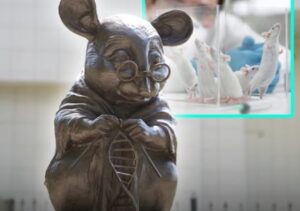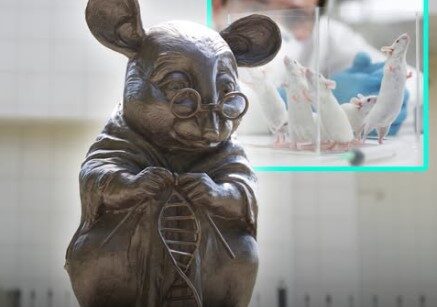The Knitting Mouse: A Monument to the Unsung Heroes of Medical Science
In the heart of Novosibirsk, Russia, stands a small but powerful tribute to one of the most essential contributors to modern science—a lab mouse. Crafted in bronze, the sculpture features a mouse calmly knitting a double helix strand of DNA, a symbol of its deep-rooted role in the evolution of genetics and medicine. At first glance, it might appear whimsical, even charming, but its meaning is profound. This humble monument recognizes the enormous impact these small mammals have had on scientific progress—and the ethical considerations that come with it.
For decades, mice have been at the forefront of biological and medical research. Their genetic similarity to humans, short life cycles, and rapid reproduction make them ideal subjects for studying everything from cancer and diabetes to neurological disorders and genetic engineering. Many of the treatments and technologies we take for granted today—including vaccines, organ transplant techniques, and cancer therapies—have origins that trace back to laboratory mice.

Yet this bronze sculpture is more than just a thank-you. It’s a conversation starter—one that encourages reflection on the human cost of discovery and the animal lives that have paved the way. Sculpted with careful detail, the mouse’s tiny paws hold knitting needles, looping DNA strands with an expression of quiet concentration. It’s not just a portrayal of science—it’s a statement about the delicate interplay between life, curiosity, and morality.
The symbolism is rich. DNA, the code of life, being knit together by a creature that, in real-world laboratories, has helped decode its mysteries. It’s a powerful visual that represents not only what science has achieved, but how it has achieved it. Scientists and ethicists alike are drawn to the sculpture as a symbol of gratitude—and as a gentle prompt to remain vigilant in the ethical treatment of animals used in research.
Russia’s decision to place such a statue in a public space reflects a growing global awareness of the moral weight behind scientific advancement. It acknowledges the unspoken contract between human innovation and the silent sacrifices made along the way. More importantly, it invites onlookers—whether they are researchers, students, or casual pedestrians—to consider the full narrative of progress.
In recent years, animal research has sparked renewed ethical debate. While many argue that the benefits to human health justify the means, others emphasize the need for more humane alternatives and stricter oversight. Technologies such as organ-on-a-chip models and AI-powered simulations are beginning to supplement—and in some cases replace—animal testing. However, as of now, lab mice still remain an irreplaceable part of the scientific journey.
The Novosibirsk sculpture thus serves as a bridge between past and future. It honors the history of discovery while pointing toward a more compassionate future in scientific inquiry. It doesn’t seek to glorify experimentation but to recognize the often-invisible role animals have played in unlocking the very codes that define life.
Standing only a few feet tall, the sculpture might be easy to miss, but its message is enduring. It reminds us that the foundations of medical innovation are not built solely on intellect and equipment, but on lives—both human and animal—intertwined by curiosity and the drive to heal.
In a world increasingly driven by technological breakthroughs and bioethical complexity, this small mouse invites us to pause and reflect. As science continues to forge ahead, so too must our compassion and sense of responsibility. The knitted DNA in the mouse’s paws is not just a metaphor for life—it’s a tapestry of shared existence, stitched together with every trial, every error, and every discovery.
Source:
Inspired by the public sculpture in Novosibirsk, Russia, and widely reported in international scientific and cultural outlets.
